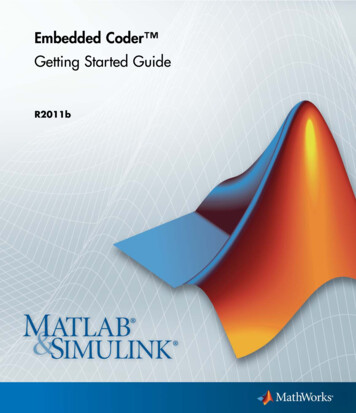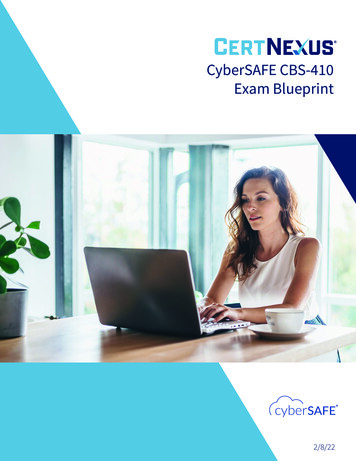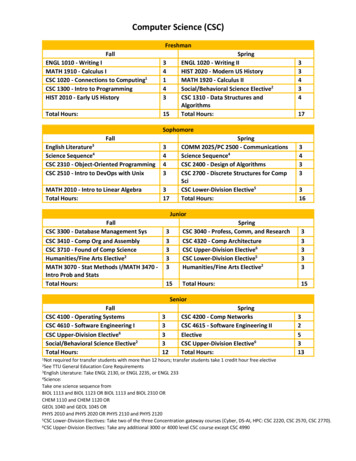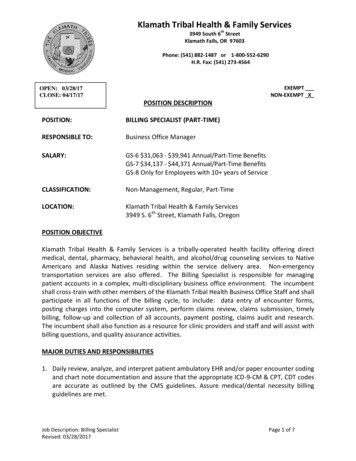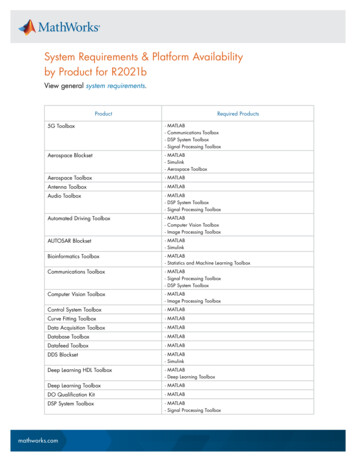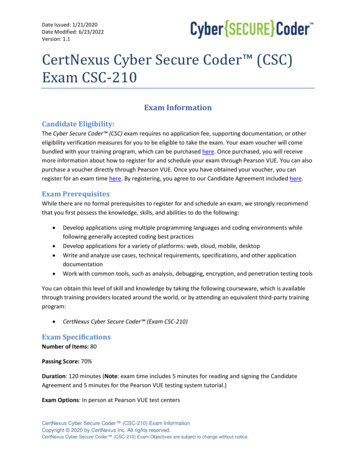
Transcription
Date Issued: 1/21/2020Date Modified: 6/23/2022Version: 1.1CertNexus Cyber Secure Coder (CSC)Exam CSC-210Exam InformationCandidate Eligibility:The Cyber Secure Coder (CSC) exam requires no application fee, supporting documentation, or othereligibility verification measures for you to be eligible to take the exam. Your exam voucher will comebundled with your training program, which can be purchased here. Once purchased, you will receivemore information about how to register for and schedule your exam through Pearson VUE. You can alsopurchase a voucher directly through Pearson VUE. Once you have obtained your voucher, you canregister for an exam time here. By registering, you agree to our Candidate Agreement included here.Exam PrerequisitesWhile there are no formal prerequisites to register for and schedule an exam, we strongly recommendthat you first possess the knowledge, skills, and abilities to do the following: Develop applications using multiple programming languages and coding environments whilefollowing generally accepted coding best practicesDevelop applications for a variety of platforms: web, cloud, mobile, desktopWrite and analyze use cases, technical requirements, specifications, and other applicationdocumentationWork with common tools, such as analysis, debugging, encryption, and penetration testing toolsYou can obtain this level of skill and knowledge by taking the following courseware, which is availablethrough training providers located around the world, or by attending an equivalent third-party trainingprogram: CertNexus Cyber Secure Coder (Exam CSC-210)Exam SpecificationsNumber of Items: 80Passing Score: 70%Duration: 120 minutes (Note: exam time includes 5 minutes for reading and signing the CandidateAgreement and 5 minutes for the Pearson VUE testing system tutorial.)Exam Options: In person at Pearson VUE test centersCertNexus Cyber Secure Coder (CSC-210) Exam InformationCopyright 2020 by CertNexus Inc. All rights reserved.CertNexus Cyber Secure Coder (CSC-210) Exam Objectives are subject to change without notice.
Item Formats: Multiple Choice/Multiple ResponseExam DescriptionTarget Candidate:This certification exam is designed for software developers, testers, and architects who may develop inmultiple programming languages for any type of platform who desire or are required to develop highlysecure applications for business and organizational use. Candidates will also have a need to author oranalyze specifications and technical requirements and develop applications that meet them.Exam Objective Statement:This exam will certify that the successful candidate has the knowledge, skills, and abilities to design anddevelop a variety of applications for various platforms, analyze security concerns outside of specificlanguages and platforms, use a number of testing and analysis tools, and mitigate against commonthreats to data and systems.To ensure exam candidates possess the aforementioned knowledge, skills, and abilities, the CyberSecure Coder (CSC) exam will test them on the following domains with the following weightings:Domain% of Examination1.0 Common Secure Application Development Terminology andConcepts2.0 Job and Process Responsibilities Related to Secure ApplicationDevelopment3.0 Architecture and Design4.0 Risk Assessment and Management5.0 Application he information that follows is meant to help you prepare for your certification exam. Thisinformation does not represent an exhaustive list of all the concepts and skills that you may betested on during your exam. The exam domains, identified previously and included in the objectiveslisting, represent the large content areas covered in the exam. The objectives within those domainsrepresent the specific tasks associated with the job role(s) being tested. The information beyond thedomains and objectives is meant to provide examples of the types of concepts, tools, skills, andabilities that relate to the corresponding domains and objectives. All of this information representsthe industry-expert analysis of the job role(s) related to the certification and does not necessarilycorrelate one-to-one with the content covered in your training program or on your exam. Westrongly recommend that you independently study to familiarize yourself with any concept identifiedhere that was not explicitly covered in your training program or products.CertNexus Cyber Secure Coder (CSC-210) Exam InformationCopyright 2020 by CertNexus Inc. All rights reserved.CertNexus Cyber Secure Coder (CSC-210) Exam Objectives are subject to change without notice.
Domain 1.0Common Secure Application Development Terminology and ConceptsObjective 1.1 Understand basic security principles Encryption Division of resources/categorization of components The CIA Triad AAA Least privilege Least common mechanism Defense in Depth Fail safe Weakest link Separation of duties MonitoringObjective 1.2 Identify common hacking terminology and concepts Black hat, gray hat, white hat Builders and breakers Social engineering Vulnerability Exploits and attacksDomain 2.0Job and process responsibilities related to secure application developmentObjective 2.1 Explain the software development lifecycle SDLC phases Secure SDLCObjective 2.2 Understand the role of the designer/architect in creating secure applications Design deliverables Whiteboarding Compliance assurance and adherence to organizational requirementsObjective 2.3 Explain the role of the developer in creating secure applications Development deliverables Debugging tools Use of standard libraries and APIsObjective 2.4 Understand the role of the code reviewer in creating secure applications Review deliverables Static analysis tools Dynamic code analysis toolsObjective 2.5 Understand the role of the application tester in creating secure applications Testing deliverables Penetration testingDomain 3.0Architecture and DesignCertNexus Cyber Secure Coder (CSC-210) Exam InformationCopyright 2020 by CertNexus Inc. All rights reserved.CertNexus Cyber Secure Coder (CSC-210) Exam Objectives are subject to change without notice.
Objective 3.1 Interpret use and abuse cases Design intentions AttacksObjective 3.2 Understand architecture and design industry best practices Modular design Design methodologies Software design patterns Security design patterns Requiring strong passwords Identity management process Design of monitoring/logging systemObjective 3.3 Identify common regulations that relate to secure software development HIPAA PCI DSS ISO 27001 SOX Country-specific privacy lawsObjective 3.4 Explain the importance of organizational requirements to the development of securesoftware applications Internal organizational processes Internal organizational policiesDomain 4.0Risk assessment and managementObjective 4.1 Classify common threats and vulnerabilities in terms of their impact on applications OWASP Top 10 CWE/SANS Top 25 Attack vectors Assets Risks Threat types Countermeasures Impacts ProbabilityObjective 4.2 Compare and contrast common risk assessment and management best practices Quantitative risk assessment Qualitative risk assessment Policy adjustments/updates Architectural reviewDomain 5.0Application ImplementationCertNexus Cyber Secure Coder (CSC-210) Exam InformationCopyright 2020 by CertNexus Inc. All rights reserved.CertNexus Cyber Secure Coder (CSC-210) Exam Objectives are subject to change without notice.
Objective 5.1 Implement input validation Input vulnerabilities Input validation techniquesObjective 5.2 Restrict the output of sensitive data Output vulnerability Output security techniquesObjective 5.3 Implement cryptography Crypto libraries Key management Algorithm implementation Secure storage of dataObjective 5.4 Implement authentication and access control Password verification Roles, permissions, groups Implementation of secure session management Account lockouts Password recoveryObjective 5.5 Implement error handling and logging Error message logging Security exception logging Log centralizationObjective 5.6 Implement communication security SSL/TLS Encrypted tunnels Mobile app considerations IoT app considerations Security of web servicesObjective 5.7 Implement application security parameters and configure security settings Parameterizing security properties and settings Configuration file protection Default passwords on third-party applicationsObjective 5.8 Implement secure database access Elimination of string concatenation for database queries Database connection access controlRecertification RequirementsThe Cyber Secure Coder (CSC) certification is valid for 3 years from the date that it is initially granted. Youmust retake the most recent version of the exam before the certification’s 3-year period expires in orderto maintain a continuously valid certification.CertNexus Cyber Secure Coder (CSC-210) Exam InformationCopyright 2020 by CertNexus Inc. All rights reserved.CertNexus Cyber Secure Coder (CSC-210) Exam Objectives are subject to change without notice.
Cyber Secure Coder (CSC) AcronymsAcronymExpanded FormAAAauthentication, authorization, and accountingCIAconfidentiality, integrity, and availabilityDoSDenial of ServiceGDPRGeneral Data Protection RegulationHIPAAHealth Insurance Portability and Accountability ActIoTInternet of ThingsIPsecInternet Protocol securityISOInternational Organization for StandardizationLDAPLightweight Directory Access ProtocolOSoperating systemOWASPOpen Web Application Security ProjectPASTAProcess for Attack Simulation and Threat AnalysisPCI DSSPayment Card Industry Data Security StandardSDLCsoftware development lifecycleSOXSarbanes-Oxley ActSSHSecure ShellSSL/TLSSecure Sockets Layer/Transport Layer SecuritySQLStructured Query LanguageVPNvirtual private networkXMLExtensible Markup LanguageXSScross-site scriptingXXEXML External EntityCertNexus Cyber Secure Coder (CSC-210) Exam InformationCopyright 2020 by CertNexus Inc. All rights reserved.CertNexus Cyber Secure Coder (CSC-210) Exam Objectives are subject to change without notice.
Secure Coder (CSC) exam will test them on the following domains with the following weightings: Domain % of Examination 1.0 Common Secure Application Development Terminology and Concepts 15% 2.0 Job and Process Responsibilities Related to Secure Application Development 15% 3.0 Architecture and Design 18% 4.0 Risk Assessment and Management 17%


